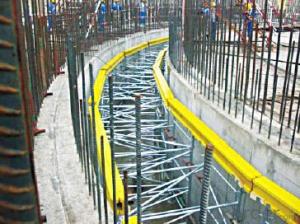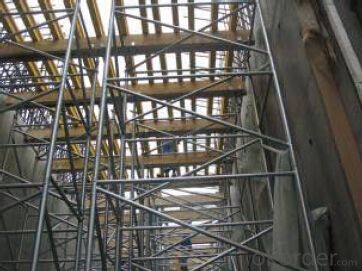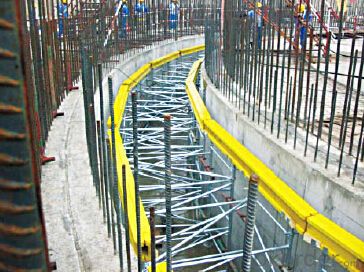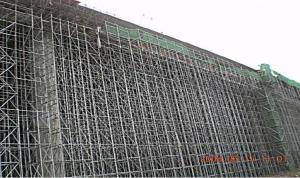Tower Scaffolding for Formwork and Scaffolding System
- Loading Port:
- Tianjin
- Payment Terms:
- TT OR LC
- Min Order Qty:
- 50 m²
- Supply Capability:
- 1000 m²/month
OKorder Service Pledge
Quality Product, Order Online Tracking, Timely Delivery
OKorder Financial Service
Credit Rating, Credit Services, Credit Purchasing
You Might Also Like
Tower Scaffolding
Shoring tower is an effective supporting system. It is easy to assemble and dismantlement, and
has excellent stability and bearing capacity. It has been widely used in the construction of industry
& residential buildings , bridges, tunnels and dam project, etc.
Characteristics:
◆ High degree of standardization.
◆ Easy storage and transportation

- Q: Can steel formwork be used for projects with stringent quality requirements?
- Steel formwork is definitely suitable for projects that have strict quality requirements. It is well-known for its durability, strength, and consistency, making it a great option for projects that require precision, accuracy, and high-quality finishes. With the ability to withstand heavy loads and maintain its shape and dimensions over multiple uses, steel formwork ensures that concrete structures are formed accurately and precisely according to design specifications. Additionally, steel formwork provides a smooth surface finish, reducing the need for extensive post-construction finishing work. Its robustness and stability make it a suitable choice for projects that require strict quality control, such as high-rise buildings, bridges, and infrastructure projects. Moreover, steel formwork allows for easy customization, enabling contractors to efficiently meet specific project requirements. Overall, steel formwork is a reliable and efficient choice for projects with stringent quality requirements, guaranteeing that the final structure meets the highest standards of quality and durability.
- Q: What are the different types of safety systems used with steel formwork?
- There are several types of safety systems used with steel formwork, including guardrails, safety nets, edge protection systems, fall arrest systems, and personal protective equipment (PPE). These systems are designed to prevent falls, provide barriers against hazardous areas, and protect workers from potential accidents or injuries while working with steel formwork.
- Q: Are all steel plates used for beam slab prefabrication
- Should be determined according to the shape of the prefabricated components, specifications, to facilitate construction, cost savings, to ensure the quality of the premise.
- Q: Can steel formwork be used for concrete structures in marine environments?
- Special considerations and precautions are necessary when using steel formwork for concrete structures in marine environments. The high levels of saltwater exposure and corrosive elements in marine environments present unique challenges for steel formwork. The steel formwork can rapidly deteriorate and rust due to the corrosive nature of seawater, which compromises its structural integrity. To mitigate these risks, it is crucial to utilize high-quality corrosion-resistant steel, such as stainless steel or galvanized steel, for the formwork. These materials have superior resistance to corrosion and can withstand the harsh marine environment for an extended period. Furthermore, proper maintenance and regular inspection are essential to promptly identify any signs of corrosion or damage and address them. This maintenance may involve regular cleaning of the formwork to remove accumulated salt or debris and applying protective coatings to prevent corrosion. Additionally, it is vital to consider the design of the formwork to ensure effective drainage and minimize water exposure. Adequate provision should be made for drainage channels and weep holes to prevent water accumulation, which can accelerate corrosion. In conclusion, successful use of steel formwork in marine environments requires careful selection of corrosion-resistant materials, regular maintenance, and proper design considerations. It is advisable to consult experienced professionals and engineers with expertise in marine construction to ensure the durability and longevity of concrete structures in such environments.
- Q: What is the process for installing steel formwork?
- The process for installing steel formwork involves several steps. Firstly, the site needs to be prepared by clearing any debris or obstacles that may interfere with the installation process. This includes ensuring that the ground is level and stable to provide a sturdy base for the formwork. Next, the steel formwork panels are positioned and secured to create the desired shape and structure. This is often done by connecting the panels together using various types of connectors, such as bolts or clamps. After the panels are securely connected, the formwork needs to be aligned and leveled to ensure the accuracy and stability of the structure being formed. This can be achieved by using leveling devices, such as laser levels or spirit levels, to ensure that the formwork is perfectly aligned and square. Once the formwork is aligned, reinforcement bars, also known as rebars, are placed within the formwork to provide additional strength and support to the concrete being poured. These rebars are positioned as per the structural drawings and are tied together using wire or metal ties. After the reinforcement is complete, the concrete is poured into the formwork. Care must be taken to ensure that the concrete is poured evenly and without any voids or air pockets. This can be achieved by using concrete vibrators to remove any trapped air and ensure proper compaction. Once the concrete has been poured, it needs to be cured properly to achieve the desired strength and durability. This can be done by covering the formwork with a curing compound or by using water curing methods, such as spraying water or covering the formwork with wet burlap. Finally, after the concrete has cured, the formwork can be removed. This is done by carefully dismantling the formwork panels and removing any connectors or supports. The formwork panels can then be cleaned and stored for reuse or transported off-site. Overall, the process for installing steel formwork requires careful planning, precise alignment, and proper execution to ensure a successful and structurally sound end result.
- Q: How does steel formwork compare to wooden formwork?
- Steel formwork is generally considered to be more durable and long-lasting compared to wooden formwork. It offers greater strength, stability, and resistance to wear and tear, making it suitable for repetitive use in construction projects. Steel formwork also provides better dimensional accuracy and allows for faster assembly and disassembly, thereby increasing overall productivity. However, steel formwork can be more expensive upfront and may require specialized equipment for handling and installation. On the other hand, wooden formwork is typically cheaper, easier to handle, and better suited for small-scale projects or temporary structures. It ultimately depends on the specific requirements of the construction project and the desired balance between cost-effectiveness and longevity.
- Q: What are the different types of form release agents used with steel formwork?
- There are several different types of form release agents that can be used with steel formwork. These agents are applied to the surface of the formwork before pouring concrete to prevent it from sticking to the steel and to facilitate easy removal of the formwork once the concrete has cured. 1. Petroleum-based form release agents: These are the most commonly used type of form release agents for steel formwork. They are made from petroleum oils and contain additives to enhance their performance. These agents provide a thin film on the surface of the steel, preventing the concrete from adhering to it. 2. Water-based form release agents: These agents are an alternative to petroleum-based ones and are preferred by some due to their environmentally-friendly nature. They are composed of water, emulsifiers, and additives that provide a barrier between the steel and concrete. Water-based agents are less volatile than petroleum-based ones and are easy to clean up. 3. Barrier release agents: Barrier release agents are formulated with a combination of waxes, resins, and polymers. They create a physical barrier between the steel and the concrete, preventing adhesion. Barrier release agents are useful when dealing with high-strength or self-consolidating concrete, which may have a stronger tendency to stick to the formwork. 4. Reactive release agents: These agents work by chemically reacting with the alkaline compounds in the concrete to form a soap-like film that prevents adhesion. Reactive release agents are typically used when a good bond between the formwork and the concrete is desired, such as in architectural concrete where a smooth surface finish is desired. 5. Dry release agents: Dry release agents are usually a powder or granular substance that is applied to the steel formwork. They work by absorbing moisture from the concrete, creating a barrier between the formwork and the concrete. Dry release agents are often used in situations where a liquid release agent may interfere with subsequent surface treatments, such as decorative coatings. It's important to note that the choice of form release agent depends on factors such as the type of steel formwork, the type of concrete being poured, the desired surface finish, and environmental considerations. It is recommended to consult with a professional or refer to manufacturer guidelines to select the most suitable form release agent for a specific project.
- Q: What are the different types of formwork joints used in steel formwork?
- In steel formwork, there are various types of formwork joints that are commonly used. These joints are designed to ensure the proper alignment, stability, and strength of the formwork system. Some of the different types of formwork joints used in steel formwork include: 1. Butt Joint: This is the most common type of joint used in steel formwork. In this joint, two formwork panels are aligned end-to-end, with the edges in direct contact with each other. The panels are then secured using bolts or clamps to ensure a tight fit. 2. Lap Joint: In a lap joint, one formwork panel overlaps the other, creating a connection between the two panels. This joint provides additional strength and stability to the formwork system. The overlapping portion is usually secured using bolts or clamps. 3. Corner Joint: As the name suggests, a corner joint is used to connect two formwork panels at a corner. This joint is typically formed by cutting and welding the panels at a 90-degree angle. The welded joint ensures a strong and secure connection between the panels. 4. T-Joint: A T-joint is formed when one formwork panel intersects another panel at a right angle, creating the shape of the letter "T". This joint is commonly used in complex formwork systems where multiple panels need to be interconnected. 5. Hinged Joint: A hinged joint is used when there is a requirement for a flexible connection between two formwork panels. This joint allows for movement and adjustment of the panels, which can be useful in situations where the formwork needs to accommodate irregular shapes or angles. 6. Slip Joint: A slip joint is used to create a temporary and adjustable connection between two formwork panels. This joint allows for easy removal and repositioning of the panels during the construction process. It is often used when the formwork needs to be adjusted for different pour heights or angles. These are just a few examples of the different types of formwork joints used in steel formwork. The choice of joint depends on the specific requirements of the construction project, including factors such as load-bearing capacity, ease of assembly and disassembly, and overall stability of the formwork system.
- Q: How does steel formwork handle concrete vibration and air entrapment?
- Steel formwork is well-suited for handling concrete vibration and air entrapment due to its strength and rigidity. Unlike other formwork materials, steel does not deform or buckle under the pressure of concrete vibration, providing a stable structure for the pouring and curing process. Additionally, steel formwork is designed with tight joints and smooth surfaces, minimizing the risk of air entrapment and ensuring proper concrete consolidation. Overall, steel formwork effectively handles concrete vibration and air entrapment, resulting in high-quality and durable concrete structures.
- Q: What are the different types of accessories used in steel formwork installation?
- There are several types of accessories used in steel formwork installation, each serving a specific purpose to ensure a successful construction process. Some common types of accessories include: 1. Wedges: These are used to secure the formwork panels in place and provide stability during concrete pouring. Wedges are inserted between the panels and tightened to hold them firmly in position. 2. Ties: Ties are essential for connecting the formwork panels together and maintaining the desired shape of the structure. They are typically made of steel and are used to prevent the panels from bulging or shifting during the pouring process. 3. Formwork clamps: These clamps are used to join the formwork components and secure them firmly in place. They are designed to withstand the pressure exerted by the wet concrete and hold the formwork system together. 4. Braces: Braces are used to provide additional support and stability to the formwork system. They help distribute the load evenly and prevent the panels from bending or collapsing under the weight of the concrete. 5. Scaffolding: Scaffolding is often used in conjunction with steel formwork installation to provide a safe working platform for workers. It allows them to access higher areas of the structure and perform various construction tasks. 6. Corner fillets: Corner fillets are used to create rounded corners in the formwork, ensuring a smooth finish and preventing sharp edges. They are made of flexible materials such as rubber or PVC and are easy to install and remove. 7. Formwork release agents: These agents are used to prevent the adhesion of concrete to the formwork surface. They create a thin barrier between the formwork and the concrete, allowing for easy removal of the formwork once the concrete has cured. 8. Formwork spacers: Spacers are used to maintain a consistent gap between the formwork and the reinforcement bars, ensuring proper concrete cover. They help prevent corrosion and enhance the structural integrity of the concrete. 9. Lifting accessories: Lifting accessories such as lifting eyes or lifting hooks are used to safely lift and move the formwork panels into position. They are designed to withstand the weight of the panels and provide a secure attachment point for cranes or other lifting equipment. These are just a few examples of the different types of accessories used in steel formwork installation. Each accessory plays a crucial role in ensuring the formwork system is sturdy, secure, and capable of withstanding the pressures of concrete pouring. It is important to choose the appropriate accessories based on the specific requirements of the construction project.
Send your message to us
Tower Scaffolding for Formwork and Scaffolding System
- Loading Port:
- Tianjin
- Payment Terms:
- TT OR LC
- Min Order Qty:
- 50 m²
- Supply Capability:
- 1000 m²/month
OKorder Service Pledge
Quality Product, Order Online Tracking, Timely Delivery
OKorder Financial Service
Credit Rating, Credit Services, Credit Purchasing
Similar products
Hot products
Hot Searches
Related keywords



















